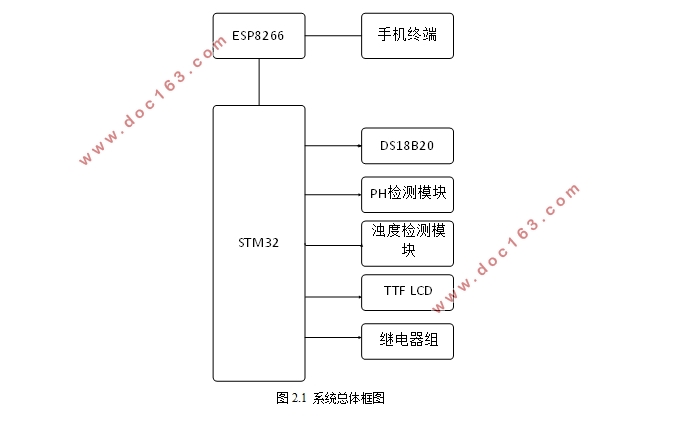智能鱼缸控制系统的设计

智能鱼缸控制系统的设计(论文11000字)
摘要:当前社会,物联网技术得到飞速发展,人类社会智能化的速度越来越快,同时,随着5G的到来,信息传播的成本进一步降低,这为智能家居的一系列产品提供了技术和商用价值。为了探索智能家居产品的开发,本设计着眼于家居产品里的鱼缸,设计了一款智能鱼缸控制系统。本设计分为两部分:第一部分采用STM32单片机,对水的温度、浊度、PH值进行检测,同时通过控制继电器的中断控制投食、加热和供氧三个模块;第二部分stm32利用Wi-Fi模块经过云服务器和手机相连,从而实现远程控制和读取参数的功能。经测试,该系统能完成温度、PH、浊度检测的功能,并可以连接手机终端,远程控制鱼缸的投食、供氧和加热,适用于日常家居。
关键词:智能家居;STM32;远程控制;鱼缸
Design and implementation of intelligent fish tank control system
Abstract:At present, the technology of IOT has been developed rapidly, the human society has become more and more intelligent, at the same time, with the advent of 5G, the cost of information transmission has been further reduced, which provides technical and commercial value for a series of products of intelligent home. In order to explore the development of intelligent home products, this design focuses on household products in the aquarium, designed a smart fish tank control system. The design is divided into two parts: the first part use STM32 single-chip microcomputer to test the water temperature、turbidity and PH , at the same time by controlling the interruption of the relay to control feeding、heating and oxygen supply ; the second part STM32 uses Wi-Fi modules to connect the cloud server and mobile phone , so as to realize remote control and read parameters. After testing, the system can complete the temperature、PH、turbidity detection function, and can connect mobile terminals to remote control fish tank to feed、supply oxygen and to heat . It is suitable for everyday home.
Key words:Smart home; STM32; Remote Control; Fish Tank

目录
第一章 绪论 1
1.1课程的研究背景与意义 1
1.2国内外研究现状 1
1.3关键技术 2
1.4 主要研究内容 2
第二章 智能鱼缸控制系统的总体设计 3
2.1系统方案 3
2.2系统要求 3
2.3主要硬件选型 4
2.3.1单片机选型 4
2.3.2 WI-FI模块 4
2.3.3温度检测模块 5
2.3.4 PH检测模块 5
2.3.5 浊度检测模块 6
2.3.6 继电器模块 6
2.4软件选择 6
第三章 智能鱼缸控制系统的硬件设计 8 [资料来源:http://www.doc163.com]
3.1总体设计 8
3.2电路设计 8
3.2.1 stm32电路设计 8
3.2.2 WI-FI模块电路设计 9
3.2.3 温度传感器模块电路设计 9
3.2.4 PH检测模块电路设计 9
3.2.5 浊度检测模块电路设计 10
3.2.6 继电器电路设计 10
第四章 智能鱼缸控制系统的软件设计 11
4.1 软件设计概述 11
4.2云平台软件设计 11
4.2.1平台介绍 11
4.2.2 ONENET数据点的建立 11
4.2.3 WI-FI模块软件设计 11
4.3单片机主程序软件设计 12
4.3.1 检测传感器软件设计 12
4.3.2 继电器模块软件设计 14
第五章 Android程序设计 16
5.1 简介 16
5.2系统开发环境的搭建 16
5.3 程序框架 16
5.4安卓文件解析 16
5.5 TCP接入ONENET 17
5.6 控制程序的设计 17
第六章 系统测试 19
6.1硬件测试 19
6.2 软件和安卓检测 19
总结与展望 21
参考文献 22
致谢 23 [资料来源:http://www.doc163.com]
